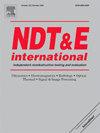Reconstruction of compressed nonlinear ultrasonic signal for self-healing process of asphalt mixture based on physics-informed neural network
IF 4.5
2区 材料科学
Q1 MATERIALS SCIENCE, CHARACTERIZATION & TESTING
引用次数: 0
Abstract
The vast quantity of data generated by ultrasonic monitoring poses challenges for efficient information transfer and significantly prolongs processing times, particularly when data must be exchanged between cloud servers and local endpoints. This situation is in stark contrast to the ongoing drive of the industry towards energy-efficient manufacturing equipment. Data compression, a standard approach for addressing this, is heavily reliant on the quality of the acquired signals, especially when it comes to nonlinear ultrasonic methods, which are sensitive to the characteristics of higher harmonics. Consequently, achieving high-fidelity signal reconstruction from compressed data is a critical challenge. This paper introduces a convolutional autoencoder physics-informed neural network (CAE-PINN) that includes a general loss term along with two terms incorporating physical information. The results demonstrate that this neural network model, which incorporates physical insights, consistently surpasses traditional signal reconstruction techniques in terms of lower reconstruction error and higher signal-to-noise ratio. Moreover, the model trained with numerical simulation datasets effectively guides the reconstruction of experimental signals. CAE-PINN also exhibits robust performance in dealing with noisy signals. Error analysis of nonlinear parameters and ablation experiment reveal that the CAE-PINN is capable of extracting intrinsic physical information from signals, allowing for the accurate recovery of true nonlinear parameters, a feat that surpasses purely data-driven approaches. With this capability, it can be confidently asserted that the CAE-PINN provides an accurate characterization of the self-healing process in asphalt mixture, even under high compression ratios. For further information on the development and replication of the CAE-PINN model, including access to the numerical simulation models and remote-control program code, please refer to the following resources.
https://github.com/Dalongna/Signal_reconstruction.
基于物理信息神经网络的沥青混合料自愈过程压缩非线性超声信号重构
超声波监测产生的大量数据对有效的信息传输提出了挑战,并大大延长了处理时间,特别是当数据必须在云服务器和本地端点之间交换时。这种情况与行业对节能制造设备的持续推动形成鲜明对比。作为解决这一问题的标准方法,数据压缩在很大程度上依赖于采集信号的质量,特别是当涉及到非线性超声方法时,它对高次谐波的特性很敏感。因此,从压缩数据中实现高保真的信号重建是一个关键的挑战。本文介绍了一种卷积自编码器物理信息神经网络(CAE-PINN),它包含一个一般损失项和两个包含物理信息的项。结果表明,该神经网络模型在较低的重构误差和较高的信噪比方面始终优于传统的信号重构技术。此外,用数值模拟数据集训练的模型可以有效地指导实验信号的重构。CAE-PINN在处理噪声信号方面也表现出鲁棒性。非线性参数的误差分析和烧蚀实验表明,CAE-PINN能够从信号中提取固有的物理信息,允许准确恢复真实的非线性参数,这一壮举超越了纯粹的数据驱动方法。有了这种能力,可以自信地断言CAE-PINN即使在高压缩比下也能准确地描述沥青混合料的自愈过程。有关CAE-PINN模型的开发和复制的进一步信息,包括访问数值模拟模型和远程控制程序代码,请参阅以下资源:https://github.com/Dalongna/Signal_reconstruction。
本文章由计算机程序翻译,如有差异,请以英文原文为准。
求助全文
约1分钟内获得全文
求助全文
来源期刊

Ndt & E International
工程技术-材料科学:表征与测试
CiteScore
7.20
自引率
9.50%
发文量
121
审稿时长
55 days
期刊介绍:
NDT&E international publishes peer-reviewed results of original research and development in all categories of the fields of nondestructive testing and evaluation including ultrasonics, electromagnetics, radiography, optical and thermal methods. In addition to traditional NDE topics, the emerging technology area of inspection of civil structures and materials is also emphasized. The journal publishes original papers on research and development of new inspection techniques and methods, as well as on novel and innovative applications of established methods. Papers on NDE sensors and their applications both for inspection and process control, as well as papers describing novel NDE systems for structural health monitoring and their performance in industrial settings are also considered. Other regular features include international news, new equipment and a calendar of forthcoming worldwide meetings. This journal is listed in Current Contents.
 求助内容:
求助内容: 应助结果提醒方式:
应助结果提醒方式:


